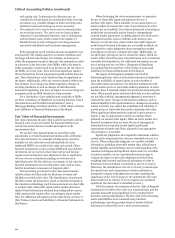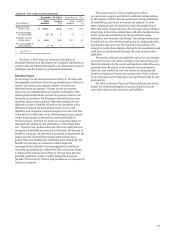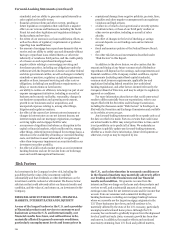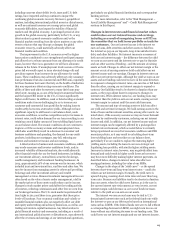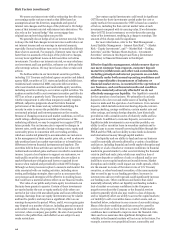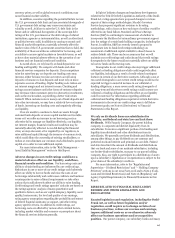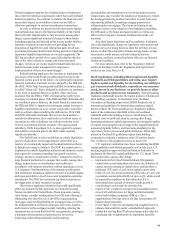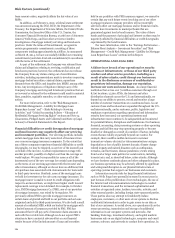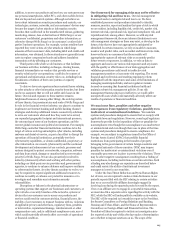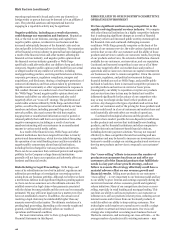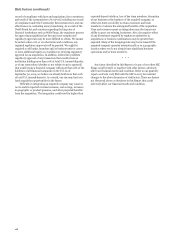Wells Fargo 2014 Annual Report Download - page 122
Download and view the complete annual report
Please find page 122 of the 2014 Wells Fargo annual report below. You can navigate through the pages in the report by either clicking on the pages listed below, or by using the keyword search tool below to find specific information within the annual report.Risk Factors (continued)
• deduct certain assets from CET1, such as deferred tax assets
that could not be realized through net operating loss carry-
backs, significant investments in non-consolidated financial
entities, and mortgage servicing rights, to the extent any one
category exceeds 10% of CET1 or all such items, in the
aggregate, exceed 15% of CET1;
• eliminate the accumulated other comprehensive income or
loss filter that applies under risk-based capital rules over a
five-year phase in period beginning in 2014; and
• comply with the Dodd-Frank Act provision prohibiting the
reliance on external credit ratings.
The final capital rules became effective for Wells Fargo in
January 2014, with certain provisions subject to phase-in
periods. The Basel III capital rules are scheduled to be fully
phased in by January 1, 2022.
In April 2014, federal banking regulators finalized a rule
that enhances the supplementary leverage ratio requirements
provided in the final capital rules for large BHCs, like
Wells Fargo, and their insured depository institutions. The rule,
which becomes effective on January 1, 2018, will require a
covered BHC to maintain a supplementary leverage ratio of at
least 5% to avoid restrictions on capital distributions and
discretionary bonus payments and require that its insured
depository institutions maintain a supplementary leverage ratio
of 6% to be considered well capitalized. In addition, in
September 2014, federal banking regulators issued a final rule
that implements a quantitative liquidity requirement consistent
with the liquidity coverage ratio (LCR) originally established by
the BCBS. The rule requires banking institutions, such as
Wells Fargo, to hold high-quality liquid assets, such as central
bank reserves and government and corporate debt that can be
converted easily and quickly into cash, in an amount equal to or
greater than its projected net cash outflows during a 30-day
stress period. The final LCR rule will be phased in beginning
January 1, 2015, and requires full compliance with a minimum
100% LCR by January 1, 2017. The FRB also recently finalized
rules imposing enhanced liquidity management standards on
large BHCs such as Wells Fargo.
The FRB has also indicated that it is in the process of
considering new rules to address the amount of equity and
unsecured debt a company must hold to facilitate its orderly
liquidation, often referred to as Total Loss Absorbing Capacity
(TLAC). In November 2014, the Financial Stability Board (FSB)
issued for public consultation policy proposals on TLAC. Under
the FSB’s TLAC proposal, global systemically important banks
(G-SIBs) would be required to hold loss absorbing equity and
unsecured debt of 16-20% of RWAs, with at least 33% of this
total being unsecured debt rather than equity. The FRB will
likely propose related rules sometime after the FSB’s public
consultation on the TLAC proposal ends.
In addition, in December 2014, the FRB proposed rules to
implement an additional CET1 capital surcharge on those U.S.
banking organizations, such as the Company, that have been
designated by the FSB as G-SIBs. The G-SIB surcharge would be
in addition to the minimum Basel III 7.0% CET1 requirement.
Under the FRB proposal, estimated surcharges for G-SIBs would
range from 1.0 to 4.5 percent of a firm’s RWAs depending on
methodologies that look at, among other things, the firm’s
systemic importance and use of short-term wholesale funding.
The G-SIB surcharge would be phased in beginning on January
1, 2016 and become fully effective on January 1, 2019.
The ultimate impact of all of these finalized and proposed or
contemplated rules on our capital and liquidity requirements
will depend on final rulemaking and regulatory interpretation of
the rules as we, along with our regulatory authorities, apply the
final rules during the implementation process.
As part of its obligation to impose enhanced capital and
risk-management standards on large financial firms pursuant to
the Dodd-Frank Act, the FRB issued a final capital plan rule that
became effective December 30, 2011. The final capital plan rule
requires top-tier BHCs, including the Company, to submit
annual capital plans for review and to obtain regulatory approval
before making capital distributions. There can be no assurance
that the FRB would respond favorably to the Company’s future
capital plans. The FRB has also finalized a number of regulations
implementing enhanced prudential requirements for large BHCs
like Wells Fargo regarding risk-based capital and leverage, risk
and liquidity management, and imposing debt-to-equity limits
on any BHC that regulators determine poses a grave threat to the
financial stability of the United States. The FRB and OCC have
also finalized rules implementing stress testing requirements for
large BHCs and national banks. The FRB has also proposed, but
not yet finalized, remediation requirements for large BHCs
experiencing financial distress that would restrict capital
distributions upon the occurrence of capital, stress test, or risk
and liquidity management triggers. The OCC, under separate
authority, has also established heightened governance and risk
management standards for large national banks, such as
Wells Fargo Bank, N.A.
The Basel standards and FRB regulatory capital and
liquidity requirements may limit or otherwise restrict how we
utilize our capital, including common stock dividends and stock
repurchases, and may require us to increase our capital and/or
liquidity. Any requirement that we increase our regulatory
capital, regulatory capital ratios or liquidity could require us to
liquidate assets or otherwise change our business, product
offerings and/or investment plans, which may negatively affect
our financial results. Although not currently anticipated,
proposed capital requirements and/or our regulators may
require us to raise additional capital in the future. Issuing
additional common stock may dilute the ownership of existing
stockholders. In addition, federal banking regulations may
increase our compliance costs as well as limit our ability to invest
in our business or provide loans or other products and services
to our customers. For more information, refer to the “Capital
Management” and “Regulatory Reform” sections in this Report
and the “Regulation and Supervision” section of our 2014
Form 10-K.
FRB policies, including policies on interest rates, can
significantly affect business and economic conditions
and our financial results and condition. The FRB
regulates the supply of money in the United States. Its policies
determine in large part our cost of funds for lending and
investing and the return we earn on those loans and
investments, both of which affect our net interest income and
net interest margin. The FRB’s interest rate policies also can
materially affect the value of financial instruments we hold, such
as debt securities and MSRs. In addition, its policies can affect
our borrowers, potentially increasing the risk that they may fail
to repay their loans. Changes in FRB policies are beyond our
control and can be hard to predict. The FRB recently reaffirmed
the target range for the federal funds rate at near zero as it
continues to assess U.S. unemployment rates and the FRB’s two
percent inflation target. The FRB has indicated that it will
consider a wide range of information, such as additional labor
market and financial market conditions, in its determination of
how long to maintain the current target range. The FRB has
stated that it intends to be patient before beginning to increase
120


